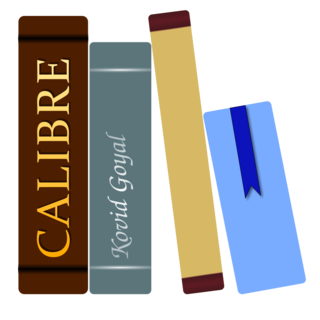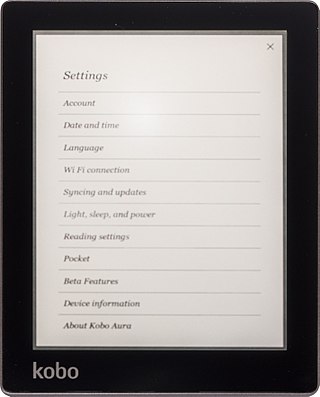An e-reader, also known as an e-book reader, is a portable electronic device that is designed primarily for the purpose of reading e-books and periodicals. E-readers have a similar form factor to a tablet and usually refers to devices that use electronic paper resulting in better screen readability, especially in bright sunlight, and longer battery life when compared to a tablet. An e-reader's battery will typically last for multiple weeks. In contrast to an e-reader, a tablet has a screen capable of higher refresh rates which make them more suitable for interaction such as playing a video game or watching a video clip.
BiblioVault is a virtual warehouse for academic books that serves more than 90 scholarly publishers in the U.S. and Europe.

Elizabeth Castro, sometimes known as Liz Castro, is an American author and translator best known for her books aimed to educate the reader on particular aspects of website development, such as HTML and Perl. From 1987 to 1993 Castro lived in Barcelona and managed the translation of computer programs. In 1993 she moved back to the United States to write books about using the internet and World Wide Web.

The Sony Reader (ソニー・リーダー) was a line of e-book readers manufactured by Sony. The first model was the PRS-500 released in September 2006 and was related to the earlier Sony Librie, the first commercial E Ink e-reader in 2004 using an electronic paper display developed by E Ink Corporation. The last model was the PRS-T3, after which Sony announced it would no longer release a new consumer e-reader.
Mobipocket SA was a French company incorporated in March 2000 that created the .mobi e-book file format and produced the Mobipocket Reader software for mobile phones, personal digital assistants (PDA) and desktop operating systems.

An e-reader, also called an e-book reader or e-book device, is a mobile electronic device that is designed primarily for the purpose of reading digital e-books and periodicals.
The following is a comparison of e-book formats used to create and publish e-books.
Amazon Kindle is a series of e-readers designed and marketed by Amazon. Amazon Kindle devices enable users to browse, buy, download, and read e-books, newspapers, magazines and other digital media via wireless networking to the Kindle Store. The hardware platform, which Amazon subsidiary Lab126 developed, began as a single device in 2007. Currently, it comprises a range of devices, including e-readers with E Ink electronic paper displays and Kindle applications on all major computing platforms. All Kindle devices integrate with Windows and macOS file systems and Kindle Store content and, as of March 2018, the store had over six million e-books available in the United States.

EPUB is an e-book file format that uses the ".epub" file extension. The term is short for electronic publication and is sometimes stylized as ePub. EPUB is supported by many e-readers, and compatible software is available for most smartphones, tablets, and computers. EPUB is a technical standard published by the International Digital Publishing Forum (IDPF). It became an official standard of the IDPF in September 2007, superseding the older Open eBook (OEB) standard.
PRC is a container format for code databases in Palm OS, Garnet OS and Access Linux Platform. Its structure is similar to PDB databases. Usually, a PRC file is a flat representation of a Palm OS application that is stored as forked database on the PDA.

Calibre is a cross-platform free and open-source suite of e-book software. Calibre supports organizing existing e-books into virtual libraries, displaying, editing, creating and converting e-books, as well as syncing e-books with a variety of e-readers. Editing books is supported for EPUB and AZW3 formats. Books in other formats like MOBI must first be converted to those formats, if they are to be edited. Calibre also has a large collection of community contributed plugins.

An ebook, also known as an e-book or eBook, is a book publication made available in electronic form, consisting of text, images, or both, readable on the flat-panel display of computers or other electronic devices. Although sometimes defined as "an electronic version of a printed book", some e-books exist without a printed equivalent. E-books can be read on dedicated e-reader devices, also on any computer device that features a controllable viewing screen, including desktop computers, laptops, tablets and smartphones.

The Nook 1st Edition is the first generation of the Nook e-book reader developed by American book retailer Barnes & Noble, based on the Android platform. The device was announced in the United States in October 2009 and was released the next month. The Nook includes Wi-Fi and AT&T 3G wireless connectivity, a six-inch E Ink display, and a separate, smaller color touchscreen that serves as the primary input device. In June 2010 Barnes & Noble announced a Wi-Fi-only model of the Nook. On June 5, 2018 Barnes and Noble announced support for logging in to BN.com and adding new content to the device will end on June 29, 2018. The second-generation Nook, the Nook Simple Touch, was announced May 25, 2011 with a June 10 release date.

The Kobo eReader is an e-reader produced by Toronto-based Kobo Inc. The company's name is an anagram of "book". The original version was released in May 2010 and was marketed as a minimalist alternative to the more expensive e-book readers available at the time. Like most e-readers, the Kobo uses an electronic ink screen. The Arc tablet series, released between 2011 and 2013, was based on LCD technology instead.
RoboBraille is a web and email service capable of converting documents into a range of accessible formats including Braille, mp3, e-books and Daisy. The service can furthermore be used to convert otherwise inaccessible documents such as scanned images and pdf files into more accessible formats. RoboBraille has been in operation since 2004 and currently serves thousands of user requests each month from users around the world. The service is available for free for strictly individual, non-commercial use. Institutional use by academic institutions is available through SensusAccess.

A reflowable document is a type of electronic document that can adapt its presentation to the output device. Typical prepress or fixed page size output formats like PostScript or PDF are not reflowable during the actual printing process because the page is not resized. For end users, the World Wide Web standard, HTML is a reflowable format as is the case with any resizable electronic page format.

The Amazon Fire, formerly called the Kindle Fire, is a line of tablet computers developed by Amazon. Built with Quanta Computer, the Kindle Fire was first released in November 2011, featuring a color 7-inch multi-touch display with IPS technology and running on Fire OS, an Android-based operating system. The Kindle Fire HD followed in September 2012, and the Kindle Fire HDX in September 2013. In September 2014, when the fourth generation was introduced, the name "Kindle" was dropped. In later generations, the Fire tablet is also able to convert into a Smart speaker turning on the "Show Mode" options, which the primary interaction will be by voice command through Alexa.

Google Play Books, formerly Google eBooks, is an ebook digital distribution service operated by Google, part of its Google Play product line. Users can purchase and download ebooks and audiobooks from Google Play, which offers over five million titles, with Google claiming it to be the "largest ebooks collection in the world". Books can be read on a dedicated Books section on the Google Play website, through the use of a mobile app available for Android and iOS, through the use of select e-readers that offer support for Adobe Digital Editions, through a web browser and reading via Google Home. Users may also upload up to 2,000 ebooks in the PDF or EPUB file formats. Google Play Books is available in 75 countries.

The Kindle Store is an online e-book e-commerce store operated by Amazon as part of its retail website and can be accessed from any Amazon Kindle, Fire tablet, or Kindle mobile app. At the launch of the Kindle in November 2007, the store had more than 88,000 digital titles available in the U.S. store. This number increased to more than 275,000 by late 2008 and exceeded 765,000 by August 2011. In July 2014, there were over 2.7 million titles available. As of March 2018, there are over six million titles available in the U.S. Content from the store is purchased online and downloaded using either Wi-Fi or Amazon's Whispernet to bring the content to the user's device. One of the innovations Amazon brought to the store was one-click purchasing which allowed users to quickly purchase an e-book. The Kindle Store uses a recommendation engine that looks at purchase history, browsing history, and reading activity, and then suggests material it thinks the user will like.

Foliate is a free e-book reading application for desktop Linux systems. The name refers to leaves, meaning "(getting) leafy" or "…-leaved".











